Filtering Data
When working with Bloomreach Engagement, you can use customer and event attributes as well as time ranges to specify and filter the data outputs you seek. This is an essential function you will use on a daily basis whether you work with analyses or campaigns.
This guide will help you understand:
- The types of filters used in Bloomreach Engagement
- The difference between customer and event filters
- What are operators and how to use them
- How to use negation
Your customers can also be filtered on a project level using the Email list hygiene filter.
Types of filters
There are 3 types of filters that you can find across all functions in Bloomreach Engagement:

All 3 types of filters are present (not only) when creating a metric
Date filters
Date filters allow you to select events that only happened within a certain time range. They work with the attribute timestamp that is automatically tracked for every event, or any attribute using the UNIX timestamp format. They are available whenever you use events for filtering. Timestamp is not available for customer attributes as these are static (as opposed to events).
You will notice that for reports, for example, you can specify a date filter for the whole report, but also for every metric individually within that report. In that case, they work with AND relationship and Bloomreach Engagement takes the intersection of them. Date filters for reports do not influence events in customer filter funnels.

Once you click on the date filter, you will notice that you can either work with absolute or relative date ranges.
Absolute date range
This works with a specific and static date range. For example, you can filter only events that happened between January 1st, 2015, and March 1st, 2016. You can remove the absolute restraint from one side by using the From start and Until now checkboxes that will appear once you click on this option. Using the example above, you can filter events that happened between January 1st, 2015 - until now, whereas the latter is relative and will always refer to the actual day.
Relative date range
As opposed to the absolute date range, this filter is relative to the current time based on the chosen time unit and hence will be constantly changing. Keep in mind these rules as they will profoundly change what outputs you receive:
- When working with days, the start of the period is the midnight of the specified day.
- For months, the start of the period is the 1st day of the specified month.
- The same logic applies to all other time units.
| Example |
|---|
The current time is June 2, 15:00. If you filter last 1 day you will get events that happened only today from 00:00, covering only 15 hours. If you want to cover the full 24 hours even going back to the previous day, then you need to select the option last 24 hours. |
The relative range can be selected from predetermined quick options or fully customized.
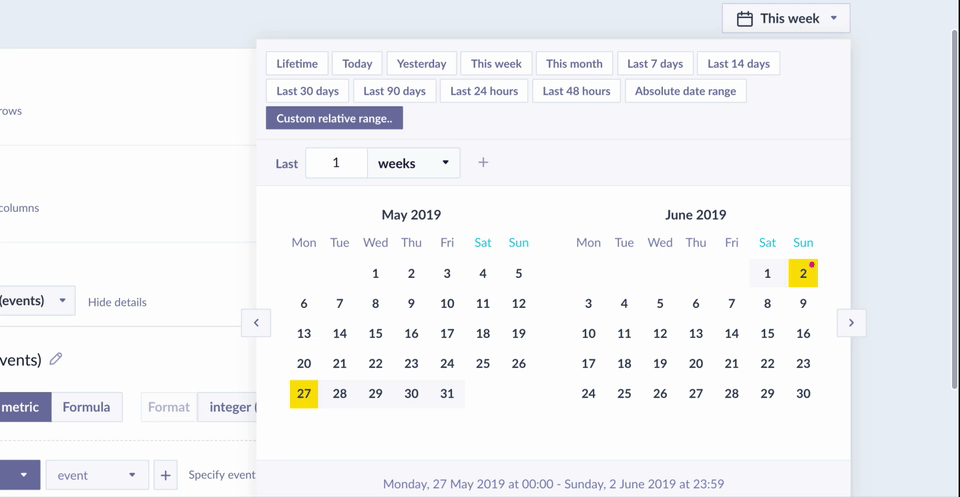
If not sure, the calendar will always show you which date range you selected. This GIF was taken on June 2nd 2019.
Don't forget
Using "last 1 week" may give you different results than "last 7 days" as explained above.
Customer filters
Customer filters can be specified when working with customer attributes as well as event metrics. These are essentially Funnels which you can read more about in the separate guide.
You can work with more customer filters and combine them using mathematical AND and OR logic, as shown in the screenshot below.
Customers can be filtered either based on attributes or funnels.
| Based on attributes | This filter will work with static (email, name, etc.) or derived (segmentations, expressions, etc.) customer attributes to determine whether a customer matches the filter or not. |
| Based on funnels | This filter works with the events of customers to determine whether a customer matches the filter or not. When working with this filter, the global date filter (in reports for example) does not apply to the events specified within the funnel. |
Please refer to the Funnels article to get a full understanding of this feature.
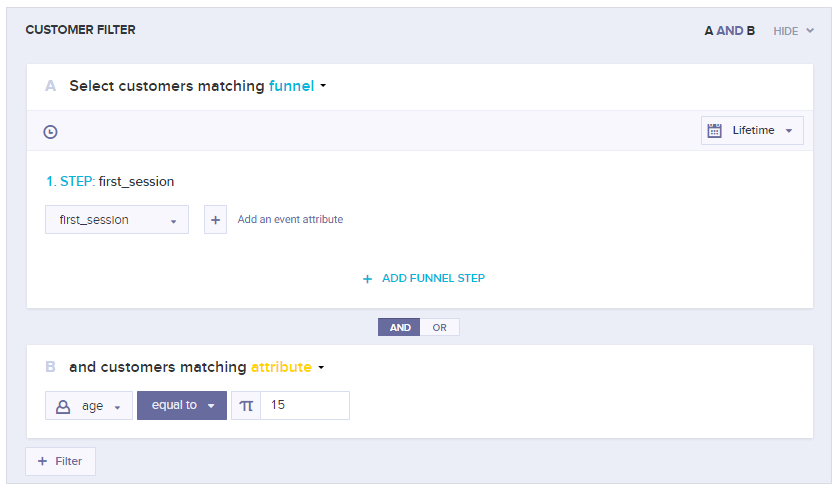
This will filter customers who have the event "first_session" tracked in their history (ever) AND have attribute "age" that is equal to 15.
Customer filter templates
This feature makes it possible to save frequently used customer filter conditions into a template, which can be re-used later to pre-fill conditions in any customer filter.
Examples include:
- filtering out your most valuable customer base using a specific list of conditions, then saving this filter as a template and re-using the same set of conditions in the email campaign audience filter.
- if you want to re-use condition nodes in scenarios that include tens of different conditions, you can save the filter as a template and re-use it in condition nodes in another scenario (no need to duplicate the whole scenario anymore).
- prepare frequently used filters for your company (e.g. list of most valuable customers), a list of people who purchased today, or a list of people you need to be excluded from any kind of campaign.
- customer filter templates work as an assisting feature, that helps you fill out frequently used conditions faster However, keep in mind that once the template is changed, changes are not propagated to all places where the template was used. in case you’d like to keep this reference, we advise using segmentations instead.
The customer filter templates are saved under Data Manager > Definitions.
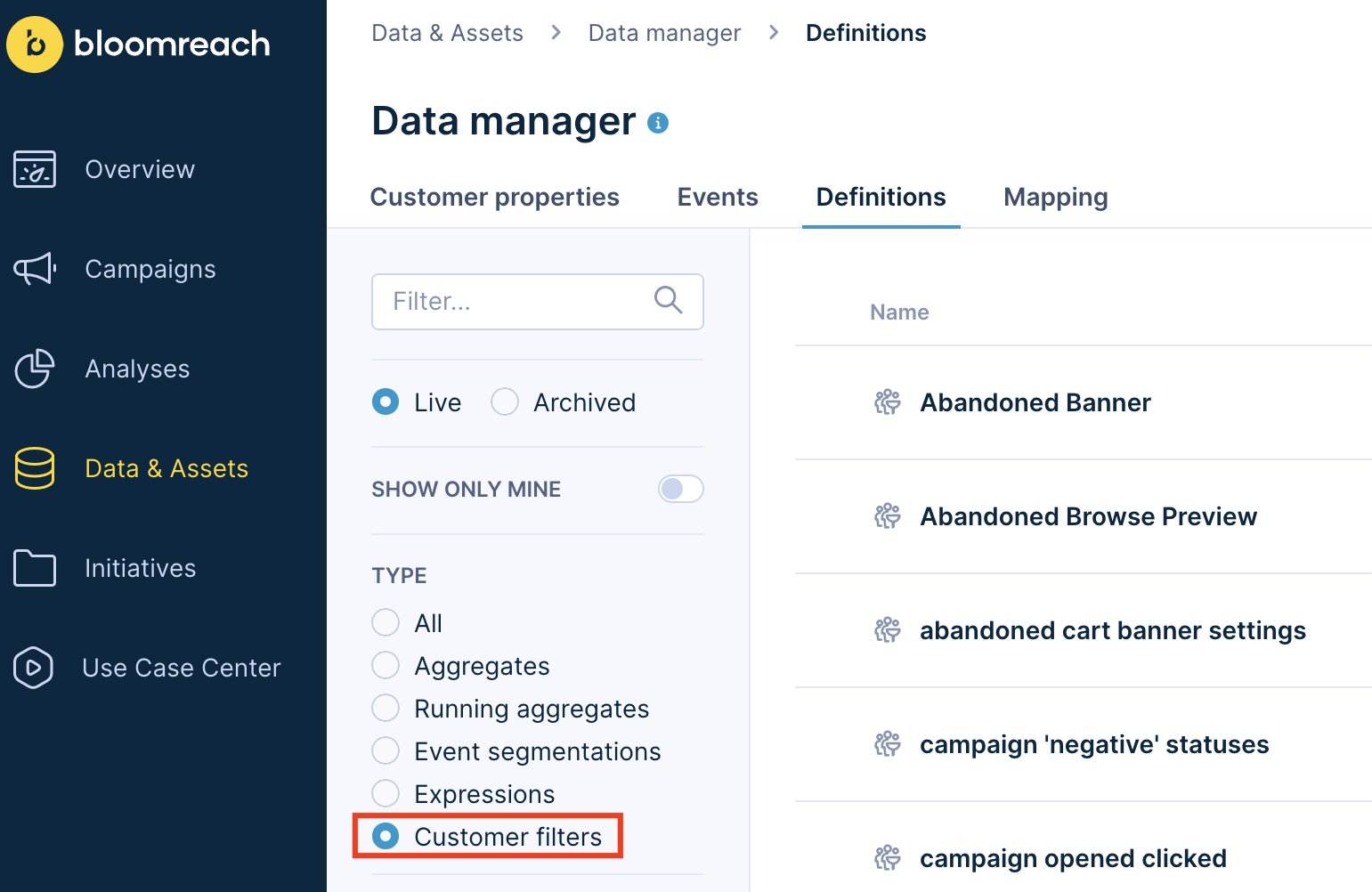
The feature will be universally accessible in all places where a customer filter can be used, including:
- Scenarios (condition node)
- Email Campaigns
- Data & Assets > Customers

Event filters
You can specify each event by its attributes. If you use more attributes at once, they are combined using AND logic, meaning the output will satisfy all conditions defined.

This will add up only the value of those purchases that had a value greater than 1000.
Using customer vs event filters
It might often be difficult to know which filter to use (and how) to achieve your desired output. While this will improve quickly with your experience, consider this example to get a better understanding of how these filters work.
You want to count how many times were viewed products with a price greater than 100.
Usually, our users approach this in two ways. Can you guess which one is correct and why?

Example 1
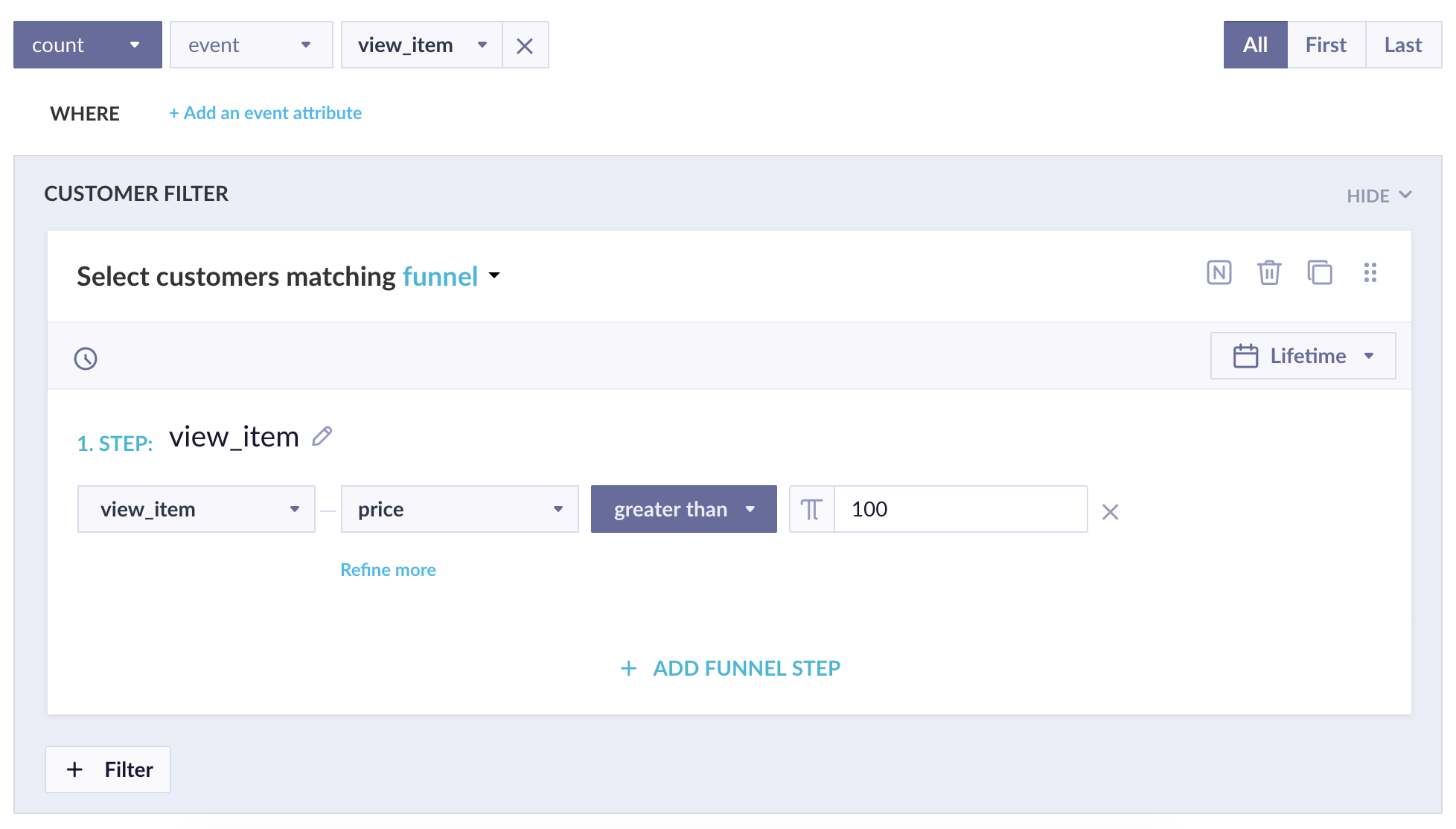
Example 2
The first screenshot depicts the correct way of achieving your desired output, while the second one is incorrect.
In the first example, you only count those product views where the price of that viewed product is greater than 100. Exactly what you want.
In the second example, however, you count all product views only done by customers who at any point in their history viewed a product with a price > 100. So if customer A viewed product 1 with a price of 200 and then product 2 with a price of 30, your filter would count 2 events. However, if customer B only viewed product 3 with a price of 40 and product 4 with a price of 50, your filter would not count any of those events as this customer never viewed a product with a price >100 and hence does not satisfy the funnel. This is obviously not the output you are seeking.
Operators
By operators, we mean the conditions you use to define a filter, such as "equal to", "greater than", "is true" etc. They are used in customer filters as well as event filters. The operators are not case-sensitive.
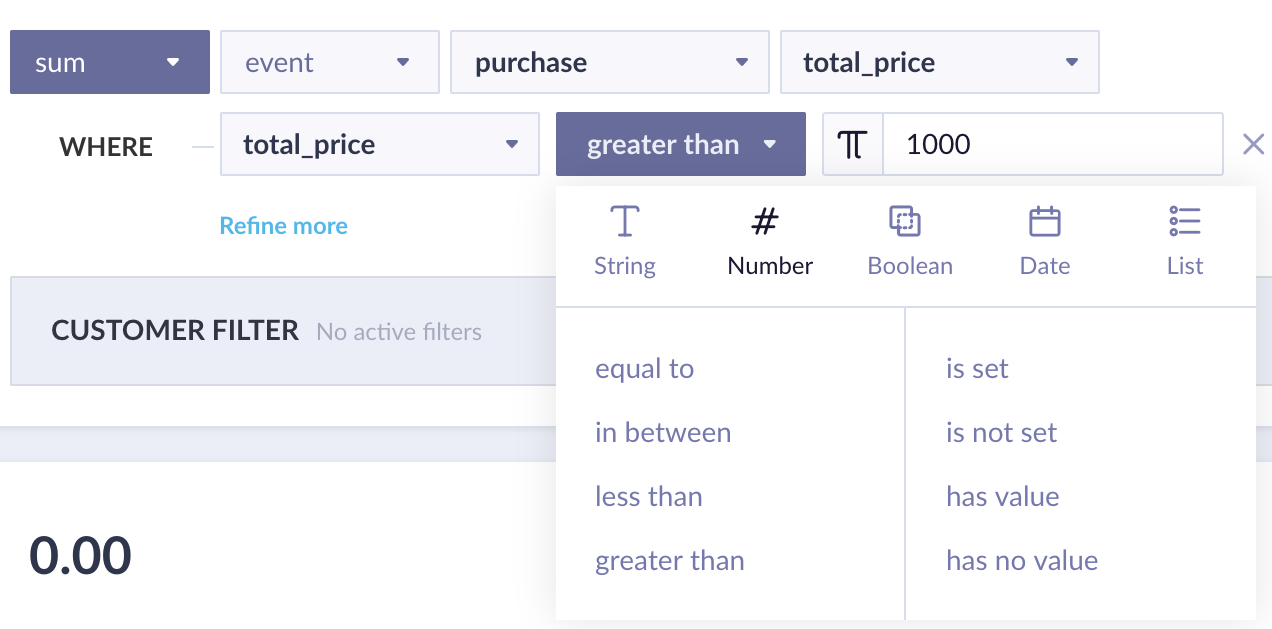
When choosing an operator, you can compare either to a static value (a number) or to another attribute by clicking on the Pi button.

There are 5 categories of operators as well as 4 special ones:
| is set | Is true if the attribute is filled, even with an 'empty' value, e.g. string with the length of 0. |
| is not set | Is true if the attribute is not filled at all (is null). |
| has value | Is true if the attribute is filled with some non-empty value (e.g. string with length > 0). |
| has no value | Is true if the attribute is filled with an empty value (e.g. string with the length of 0) or if the attribute is not filled at all (is null). |
String operators
String operators compare the exact match of characters to the specified value as in the following image:

All the operators are explained in the following table:
| equals | The value must be identical to this string. |
| does not equal | The value must be set, but different than the specified string. Read more about how to use negation later in this guide. |
| in | The value must be matching one of the operands selected from a list. There is a limit of 5 000 entered operands. |
| not in | The value must be different than all specified values - the value must be set, but different than the specified values. There is a limit of 5 000 entered values. Read more about how to use negation later in this guide. |
| contains | The value specified must be a part of the attribute. |
| does not contain | The value specified must not be a part of the attribute. Read more about how to use negation later in this guide. |
| starts with | The value must be identical to the first characters of the string. |
| ends with | The value must be identical to the last characters of the string. |
| matches regexp | The value must match the regular expression function. You can use a standard regexp as defined -0": "in",(https://github.com/google/re2/wiki/Syntax). By default, the regexp is not case sensitive but you can make it so by the following inline case-sensitive flag (?-i) e.g. (?-i).*[a-z].* (https://www.regular-expressions.info/modifiers.html). |
List data types
When filtering list data type with all_items, the filter will match also empty lists without any value. This is because „all items equals XXX" and thus returns TRUE even in case of an empty list. To avoid this behaviour add a condition "> has value" so you match only lists which have some value in it.
Number operators
Number operators work with values which are numbers and can be mathematically compared:
- equals
- in between
- less than
- more than
A common errors
A statement such as
more than 1000(or less than) excludes the value itself. A frequent mistake made in segmentations, for example, is when one segment is filtered asage is less than 18and the other asage is more than 18, so those who are 18 don't fall into any group!Another common error is when using the
in betweenoperator which includes both limit values. This means that when you create two segments, such asin between 0 and 50andin between 50 and 100, the value 50 of that given attribute will be included in both segments.
Boolean operators
Boolean operators work with the values "true" and "false" and also with "1" and "0". If an attribute doesn't have any value or has a value different to these, neither of these operators will select it.
| is true |
| is false |
Date operators
These operators compare attributes in the date format to the current time. To better understand how to work with these operators, see the examples section.
| more than | A relative time period in the past or future that is further away than the specified time restraint. |
| less than | A relative time period in the past or future that is closer than the specified time restraint. |
| matches range | Any date within the specified absolute date range. |
| matches current day | If the day of the month of the date attribute matches the day of the month of the current day. |
| matches current month | If the month of the date attribute matches the current month. |
| matches current year | If the year of the date attribute matches the current year. |
| second matches | Checks whether your event happened in a given second of a minute. Can be a number between 1-60. |
| minute matches | Checks whether your event happened in a given minute of an hour. Can be a number between 1-60. |
| hour matches | Checks whether your event happened in a given hour of a day. Can be a number between 1-24. |
| weekday matches | Checks whether your event happened on a given day of a week. Can be a number between 1-7 (1 = Monday). |
| day matches | Checks whether your event happened on a given day of a month. Can be a number between 1-31. |
| month matches | Checks whether your event happened in a given month of a year. Can be a number between 1-12. |
| year matches | Checks whether your event happened in a given year. Enter the actual number of the year (such as 2019). |
Supported operators for catalogs
In Bloomreach Engagement, you can use the following operators with catalogs:
- More than
- Less than
- Matches range
- Matches current year
Supported time formats
- UNIX timestamp
- Y-M-D, Y-M-D H:M, Y-M-D H: M: S,
- D-M-Y, D-M-Y H:M, D-M-Y H: M:S
- M/D/Y, M/D/Y H:M, M/D/Y H: M:S
- D.M.Y, D.M.Y H:M, D.M.Y H: M:S
List operators
List operators combine one of the previous operators with an ability to choose if all items from the list must fulfill the conditions or if it's enough that at least one item fulfills the condition.
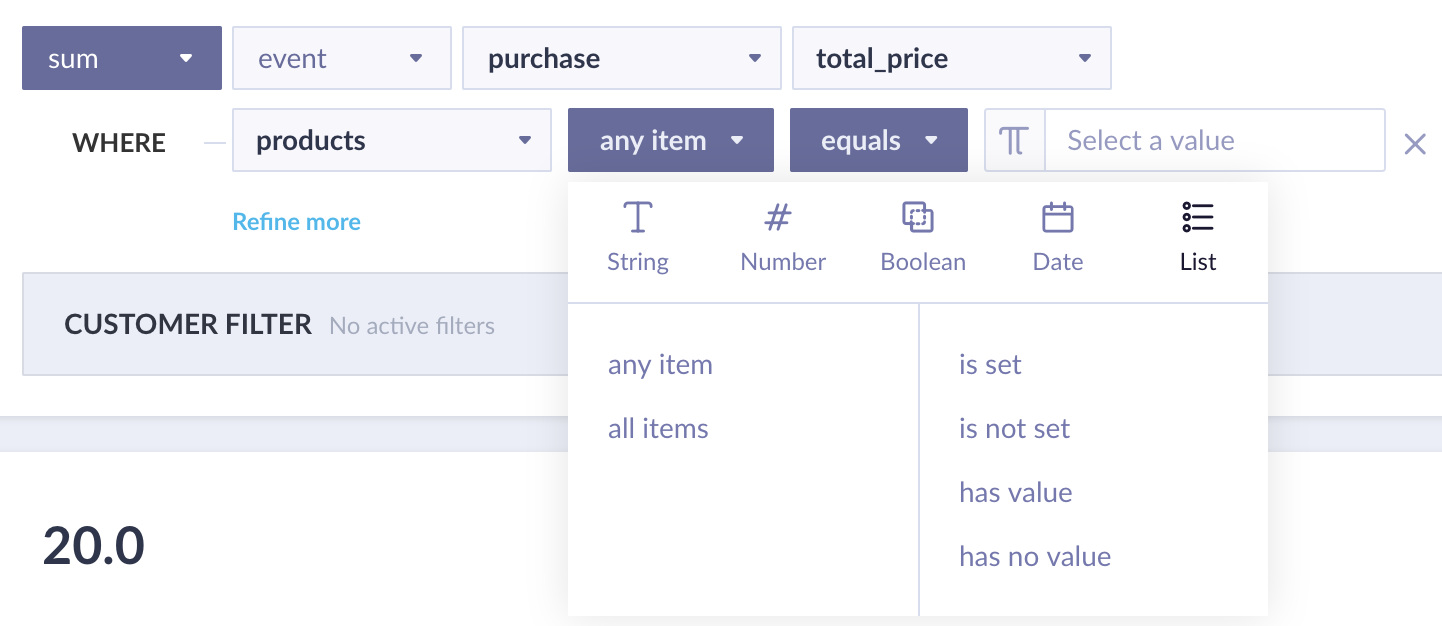
Negation
Using negation is often a better way how to get your desired outcome. There are two ways how you can negate a filter:
1. Use a negation from the drop-down within the filter.
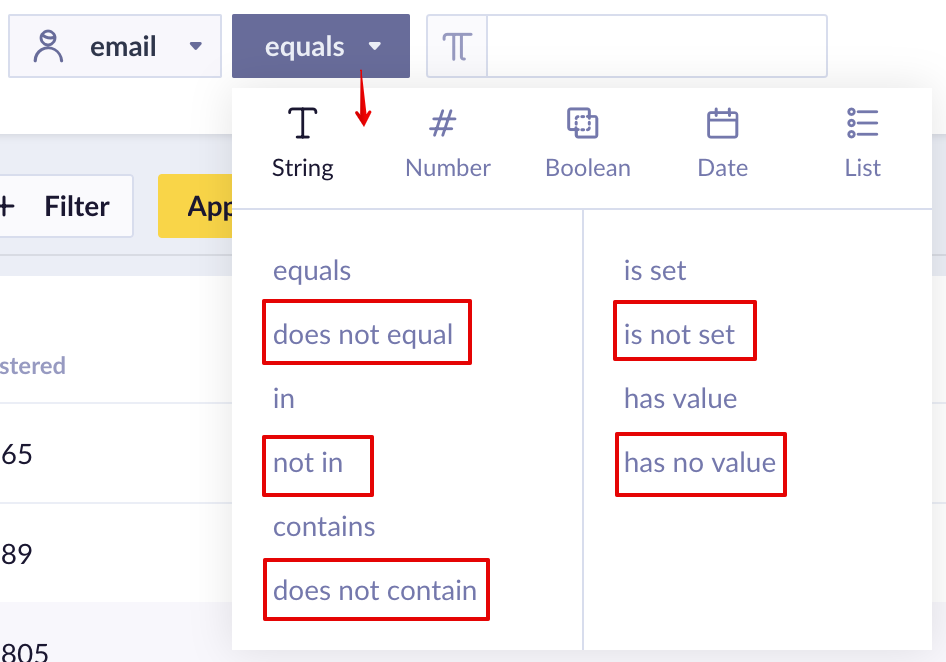
This kind of negation will literally choose only customers meeting given conditions. E.g. when choosing customers which email doesn't contain a certain word, this will show only those customers. It will not show customers without email set at all.

2. Use negation for the whole filter.
This kind of negation will choose customers not meeting the given conditions. The main difference to direct negation shown above is that this negation will include customers without set attribute as well. E.g. when choosing customers whose email doesn't contain a certain word, this will show those customers + customers without email set. To enable this negation, you need to click on the "N" button located on the right side as indicated in the screenshot below.

Notice that this approach filters more customers than in the screenshot above.
Filtering logic
Our filtering data logic is based on mathematical De Morgan's laws that explain the boolean logic behind the operators OR and AND in terms of negotiation. Let's give you an example scenario: You would like to filter customers who had marketing consent AND who did NOT buy product_123 AND did NOT buy product_456. So you would like to exclude all users that bought product_123 and product_456. In the filtering, you should therefore use this filter logic: A AND (NOT B OR NOT C) as it agrees with De Morgan's laws.
Maximum number of conditions
The maximum limit of conditions that can be used in the filter is 26 (Alphabet from A-Z). Once you reach this limit you can't add new filter conditions to the one data filter.
Examples
Filter customers who have an anniversary of purchase today
"Today" is relative and always refers to the current day. This will represent a yearly cycle

Filter customers who purchased on the first day (1.1.) of any year
This refers to a fixed day in a year

Updated 10 months ago
